2023 TOYOTA 86 engine
[x] Cancel search: enginePage 189 of 449
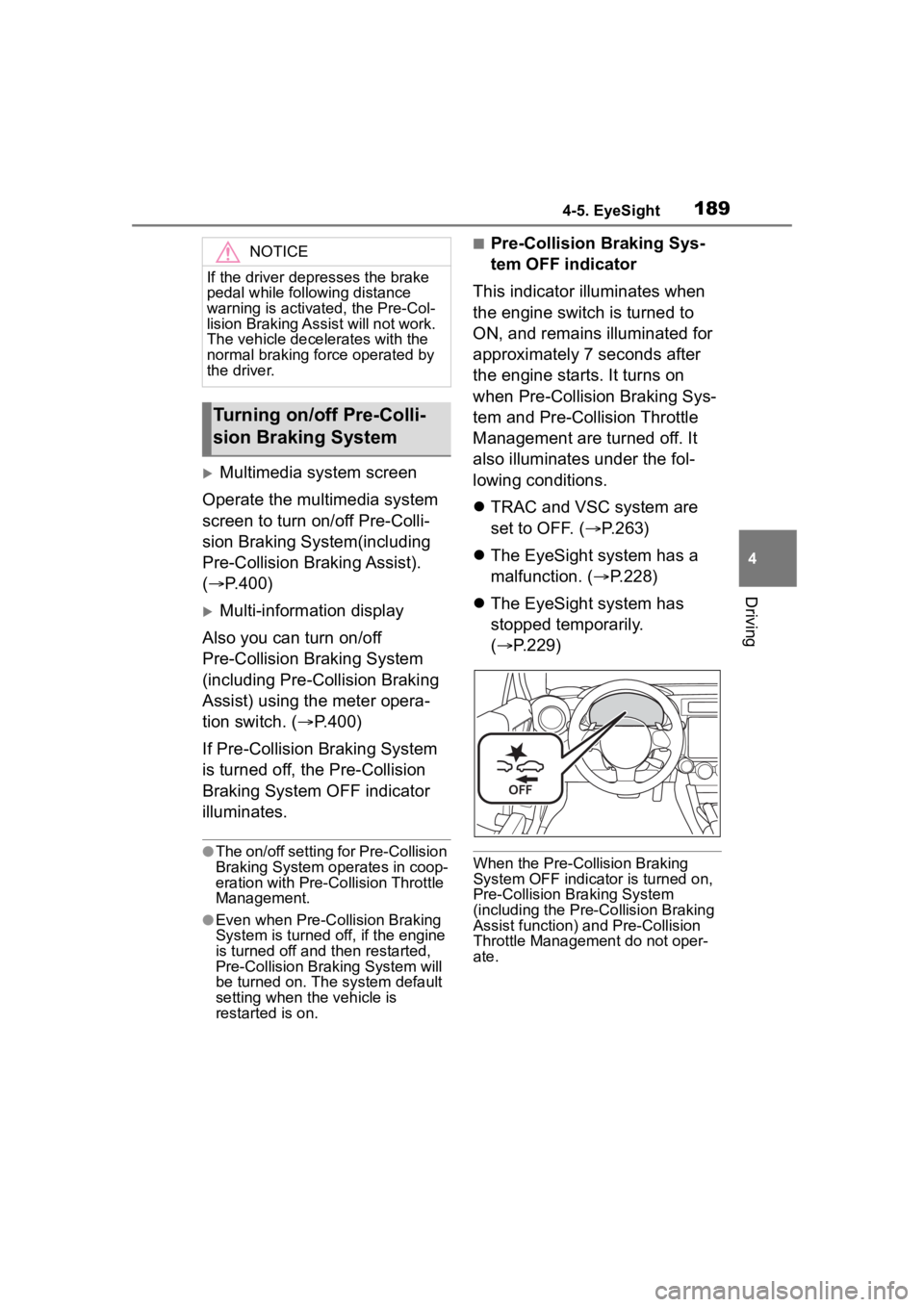
1894-5. EyeSight
4
Driving
Multimedia system screen
Operate the multimedia system
screen to turn on/off Pre-Colli-
sion Braking System(including
Pre-Collision Braking Assist).
( P.400)
Multi-information display
Also you can turn on/off
Pre-Collision Braking System
(including Pre-Collision Braking
Assist) using the meter opera-
tion switch. ( P.400)
If Pre-Collision Braking System
is turned off, the Pre-Collision
Braking System OFF indicator
illuminates.
●The on/off setting for Pre-Collision
Braking System operates in coop-
eration with Pre-Collision Throttle
Management.
●Even when Pre-Collision Braking
System is turned off, if the engine
is turned off and then restarted,
Pre-Collision Brak ing System will
be turned on. The system default
setting when the vehicle is
restarted is on.
■Pre-Collision Braking Sys-
tem OFF indicator
This indicator illuminates when
the engine switch is turned to
ON, and remains illuminated for
approximately 7 seconds after
the engine starts. It turns on
when Pre-Collision Braking Sys-
tem and Pre-Collision Throttle
Management are turned off. It
also illuminates under the fol-
lowing conditions.
TRAC and VSC system are
set to OFF. ( P.263)
The EyeSight system has a
malfunction. ( P.228)
The EyeSight system has
stopped temporarily.
( P.229)
When the Pre-Collision Braking
System OFF indicato r is turned on,
Pre-Collision Braking System
(including the Pre-Collision Braking
Assist function) and Pre-Collision
Throttle Managemen t do not oper-
ate.
NOTICE
If the driver depresses the brake
pedal while follo wing distance
warning is activat ed, the Pre-Col-
lision Braking Assist will not work.
The vehicle decelerates with the
normal braking force operated by
the driver.
Turning on/off Pre-Colli-
sion Braking System
Page 196 of 449
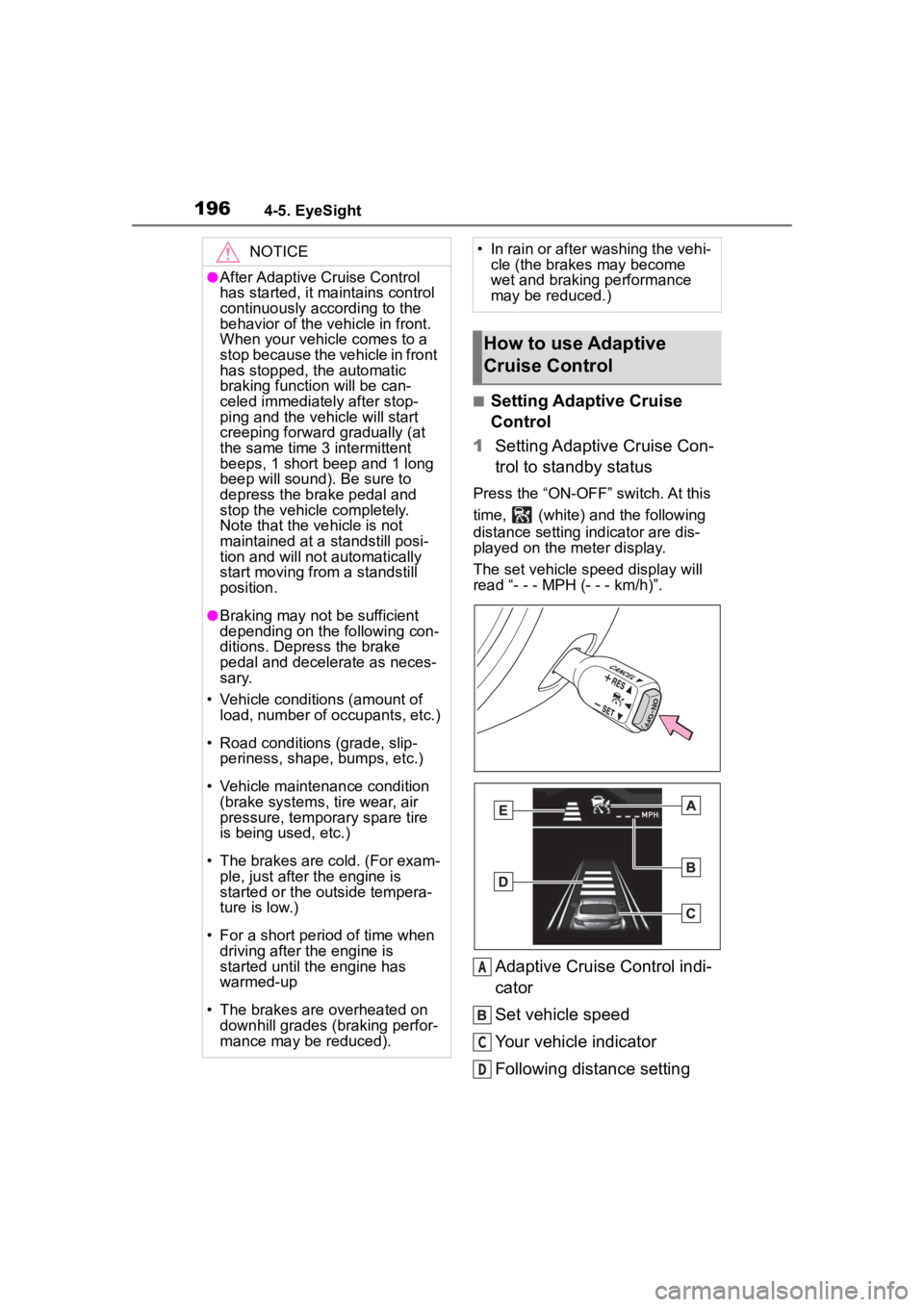
1964-5. EyeSight
■Setting Adaptive Cruise
Control
1 Setting Adaptive Cruise Con-
trol to standby status
Press the “ON-OFF” switch. At this
time, (white) and the following
distance setting indicator are dis-
played on the meter display.
The set vehicle speed display will
read “- - - MPH (- - - km/h)”.
Adaptive Cruise Control indi-
cator
Set vehicle speed
Your vehicle indicator
Following distance setting
NOTICE
●After Adaptive Cruise Control
has started, it maintains control
continuously according to the
behavior of the vehicle in front.
When your vehicle comes to a
stop because the vehicle in front
has stopped, the automatic
braking function will be can-
celed immediately after stop-
ping and t he vehicle will start
creeping forward gradually (at
the same time 3 intermittent
beeps, 1 short beep and 1 long
beep will sound). Be sure to
depress the brake pedal and
stop the vehicle completely.
Note that the vehicle is not
maintained at a standstill posi-
tion and will not automatically
start moving from a standstill
position.
●Braking may not be sufficient
depending on the following con-
ditions. Depress the brake
pedal and decelerate as neces-
sary.
• Vehicle conditions (amount of load, number of occupants, etc.)
• Road conditions (grade, slip- periness, shape, bumps, etc.)
• Vehicle maintenance condition (brake systems, tire wear, air
pressure, temporary spare tire
is being used, etc.)
• The brakes are cold. (For exam- ple, just after the engine is
started or the outside tempera-
ture is low.)
• For a short period of time when driving after the engine is
started until the engine has
warmed-up
• The brakes are overheated on downhill grades (braking perfor-
mance may be reduced).
• In rain or after washing the vehi- cle (the brakes may become
wet and braking performance
may be reduced.)
How to use Adaptive
Cruise Control
A
C
D
Page 204 of 449
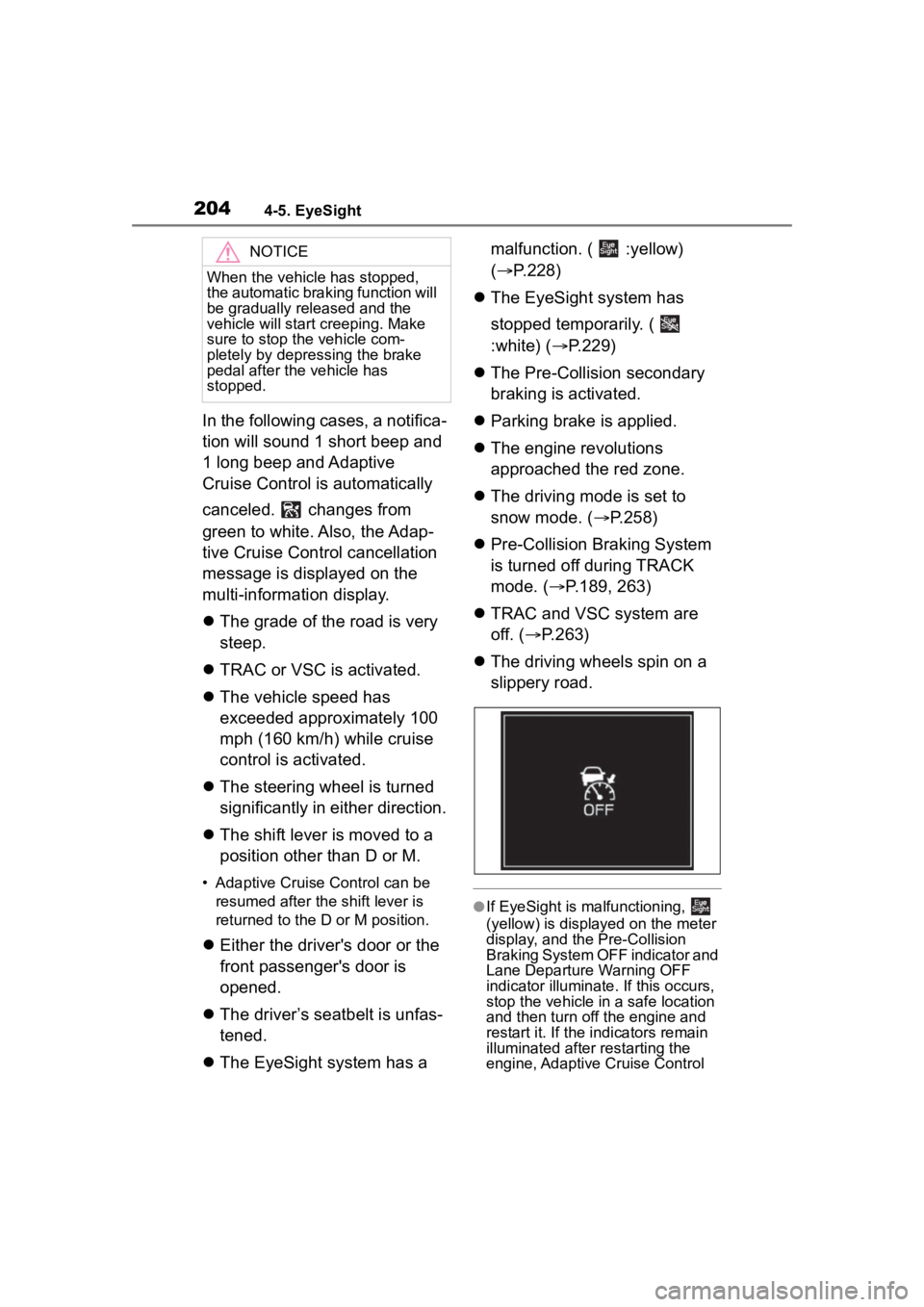
2044-5. EyeSight
In the following cases, a notifica-
tion will sound 1 short beep and
1 long beep and Adaptive
Cruise Control is automatically
canceled. changes from
green to white. Also, the Adap-
tive Cruise Control cancellation
message is displayed on the
multi-information display.
The grade of the road is very
steep.
TRAC or VSC is activated.
The vehicle speed has
exceeded approximately 100
mph (160 km/h) while cruise
control is activated.
The steering wheel is turned
significantly in either direction.
The shift lever is moved to a
position other than D or M.
• Adaptive Cruise Control can be
resumed after the shift lever is
returned to the D or M position.
Either the driver's door or the
front passenger's door is
opened.
The driver’s seatbelt is unfas-
tened.
The EyeSight system has a malfunction. ( :yellow)
(
P.228)
The EyeSight system has
stopped temporarily. (
:white) ( P.229)
The Pre-Collision secondary
braking is activated.
Parking brake is applied.
The engine revolutions
approached the red zone.
The driving mode is set to
snow mode. ( P.258)
Pre-Collision Braking System
is turned off during TRACK
mode. ( P.189, 263)
TRAC and VSC system are
off. ( P.263)
The driving wheels spin on a
slippery road.
●If EyeSight is malfunctioning,
(yellow) is displayed on the meter
display, and the Pre-Collision
Braking System OFF indicator and
Lane Departure Warning OFF
indicator illuminate. If this occurs,
stop the vehicle in a safe location
and then turn off the engine and
restart it. If the in dicators remain
illuminated after restarting the
engine, Adaptive Cruise Control
NOTICE
When the vehicle has stopped,
the automatic braking function will
be gradually released and the
vehicle will start creeping. Make
sure to stop the vehicle com-
pletely by depressing the brake
pedal after the vehicle has
stopped.
Page 205 of 449
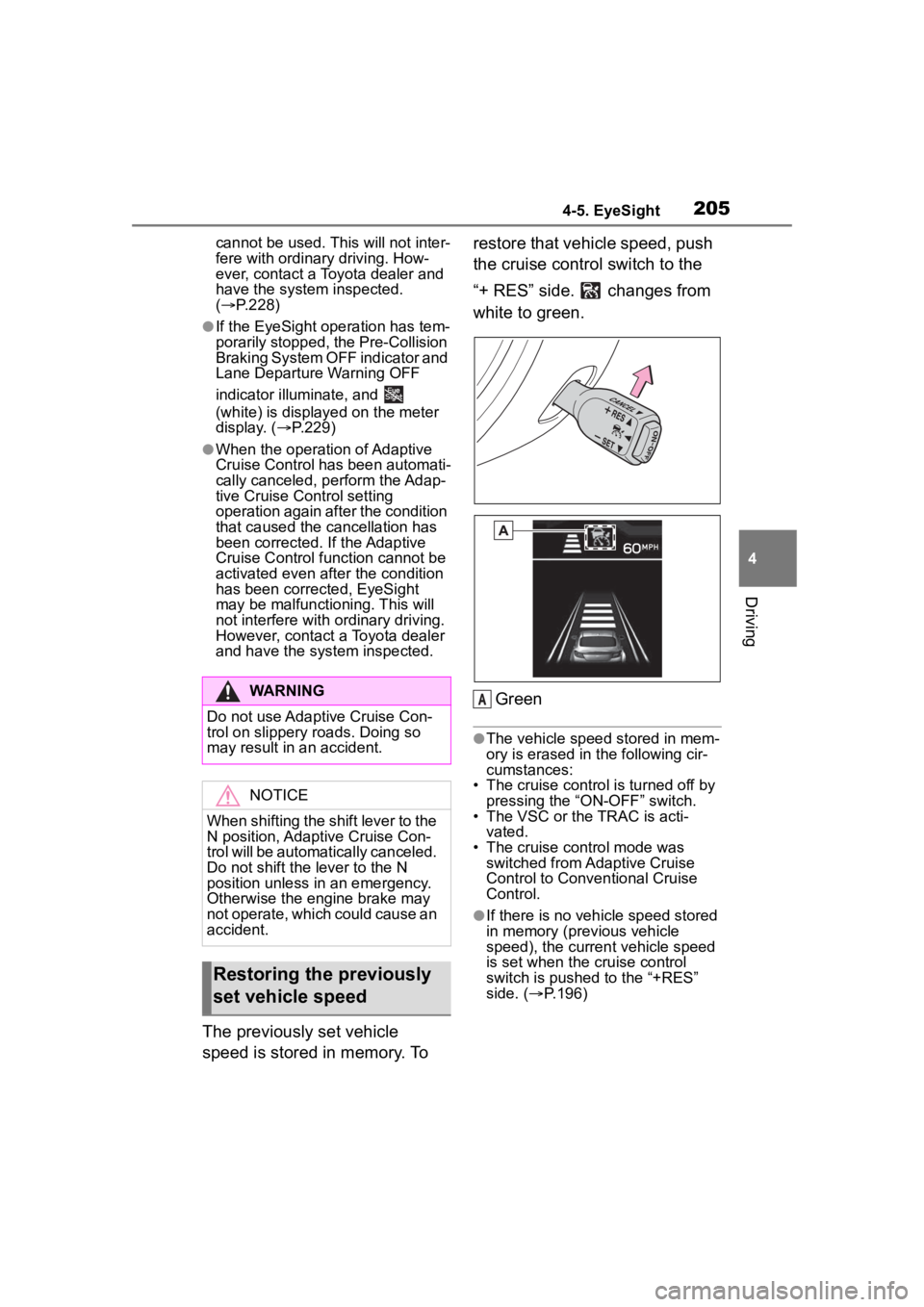
2054-5. EyeSight
4
Driving
cannot be used. This will not inter-
fere with ordinary driving. How-
ever, contact a Toyota dealer and
have the system inspected.
( P.228)
●If the EyeSight operation has tem-
porarily stopped, the Pre-Collision
Braking System OFF indicator and
Lane Departure Warning OFF
indicator illuminate, and
(white) is displayed on the meter
display. ( P.229)
●When the operation of Adaptive
Cruise Control has been automati-
cally canceled, p erform the Adap-
tive Cruise Control setting
operation again after the condition
that caused the cancellation has
been corrected. If the Adaptive
Cruise Control func tion cannot be
activated even after the condition
has been corrected, EyeSight
may be malfunctioning. This will
not interfere with ordinary driving.
However, contact a Toyota dealer
and have the system inspected.
The previously set vehicle
speed is stored in memory. To restore that vehicle speed, push
the cruise control switch to the
“+ RES” side. changes from
white to green.
Green
●The vehicle speed stored in mem-
ory is erased in the following cir-
cumstances:
• The cruise control is turned off by pressing the “ON-OFF” switch.
• The VSC or the TRAC is acti- vated.
• The cruise control mode was
switched from Adaptive Cruise
Control to Conve ntional Cruise
Control.
●If there is no vehicle speed stored
in memory (previous vehicle
speed), the current vehicle speed
is set when the cruise control
switch is pushed to the “+RES”
side. ( P.196)
WARNING
Do not use Adaptive Cruise Con-
trol on slippery roads. Doing so
may result in an accident.
NOTICE
When shifting the shift lever to the
N position, Adaptive Cruise Con-
trol will be automatically canceled.
Do not shift the lever to the N
position unless in an emergency.
Otherwise the engine brake may
not operate, which could cause an
accident.
Restoring the previously
set vehicle speed
A
Page 213 of 449
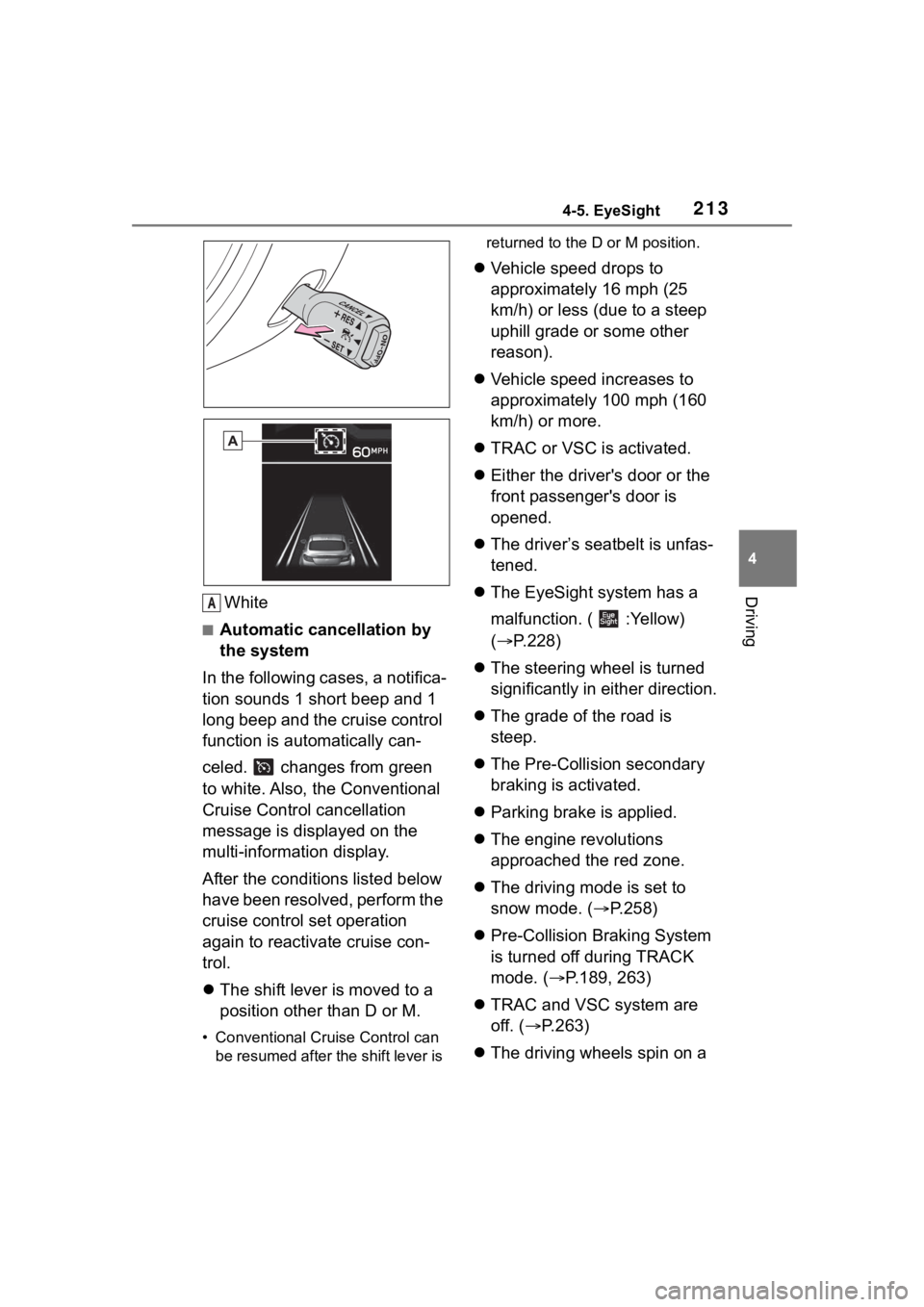
2134-5. EyeSight
4
DrivingWhite
■Automatic cancellation by
the system
In the following cases, a notifica-
tion sounds 1 short beep and 1
long beep and the cruise control
function is automatically can-
celed. changes from green
to white. Also, the Conventional
Cruise Control cancellation
message is displayed on the
multi-information display.
After the conditi ons listed below
have been resolved, perform the
cruise control set operation
again to reactivate cruise con-
trol.
The shift lever is moved to a
position other than D or M.
• Conventional Cruise Control can
be resumed after the shift lever is returned to the D or M position.
Vehicle speed drops to
approximately 16 mph (25
km/h) or less (due to a steep
uphill grade or some other
reason).
Vehicle speed increases to
approximately 100 mph (160
km/h) or more.
TRAC or VSC is activated.
Either the driver's door or the
front passenger's door is
opened.
The driver’s seatbelt is unfas-
tened.
The EyeSight system has a
malfunction. ( :Yellow)
( P.228)
The steering wheel is turned
significantly in either direction.
The grade of the road is
steep.
The Pre-Collision secondary
braking is activated.
Parking brake is applied.
The engine revolutions
approached the red zone.
The driving mode is set to
snow mode. ( P.258)
Pre-Collision Braking System
is turned off during TRACK
mode. ( P.189, 263)
TRAC and VSC system are
off. ( P.263)
The driving wheels spin on a
A
Page 214 of 449

2144-5. EyeSight
slippery road.
●If EyeSight is malfunctioning,
(yellow) is displayed on the meter
display, and the Pre-Collision
Braking System OFF indicator and
Lane Departure Warning OFF
indicator will also illuminate. If this
occurs, stop the vehicle in a safe
location and then turn off the
engine and restart it. If the indica-
tors remain illuminated after
restarting the engine, Conven-
tional Cruise Control cannot be
used. This will not interfere with
ordinary driving. However, con-
tact a Toyota dealer and have the
system inspected. ( P.228)
●When operation of Conventional
Cruise Control has been automati-
cally canceled, perform the set
operation again after the condition
that caused the cancellation has
been resolved. If cruise control
cannot be activated even after the
condition has been corrected,
EyeSight may be malfunctioning.
This will not interfere with ordinary
driving. However, contact a Toyota
dealer and have the system
inspected.
■Restoring the previously
set vehicle speed
The previously set vehicle
speed is stored in memory. To
restore that vehicle speed, push
the cruise control switch to the
“+ RES” side. changes from
white to green.
You can restore the set vehicle
speed when the previously set
vehicle speed has been stored
and the current vehicle speed is
approximately 20 mph (30 km/h)
or more.
WARNING
Do not use Conventional Cruise
Control on slippery roads. Doing
so may result in an accident.
NOTICE
When shifting the shift lever to the
N position, Conventional Cruise
Control will be aut omatically can-
celed. Do not shift the lever to the
N position unless in an emer-
gency. Otherwise the engine
brake may not operate, which
could cause an accident.
Page 215 of 449
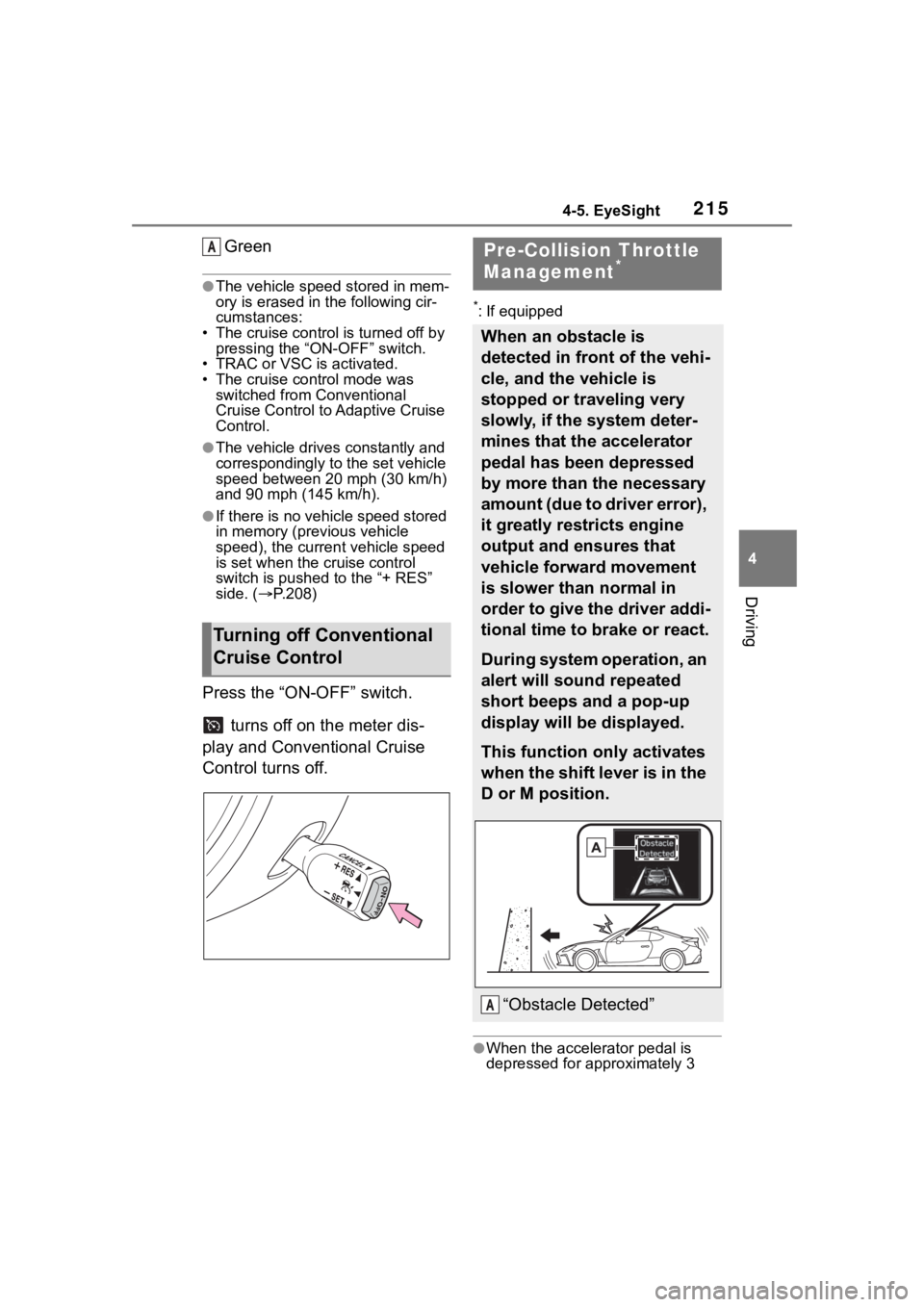
2154-5. EyeSight
4
Driving
Green
●The vehicle speed stored in mem-
ory is erased in the following cir-
cumstances:
• The cruise control is turned off by pressing the “ON-OFF” switch.
• TRAC or VSC is activated.
• The cruise control mode was
switched from Conventional
Cruise Control to Adaptive Cruise
Control.
●The vehicle drives constantly and
correspondingly to the set vehicle
speed between 20 mph (30 km/h)
and 90 mph (145 km/h).
●If there is no vehicle speed stored
in memory (previous vehicle
speed), the current vehicle speed
is set when the cruise control
switch is pushed to the “+ RES”
side. ( P.208)
Press the “ON-OFF” switch.
turns off on the meter dis-
play and Conventional Cruise
Control turns off.
*: If equipped
●When the accele rator pedal is
depressed for approximately 3
Turning off Conventional
Cruise Control
APre-Collision Throttle
Management*
When an obstacle is
detected in front of the vehi-
cle, and the vehicle is
stopped or traveling very
slowly, if the system deter-
mines that the accelerator
pedal has been depressed
by more than the necessary
amount (due to driver error),
it greatly restricts engine
output and ensures that
vehicle forward movement
is slower than normal in
order to give the driver addi-
tional time to brake or react.
During system operation, an
alert will sound repeated
short beeps and a pop-up
display will be displayed.
This function only activates
when the shift lever is in the
D or M position.
“Obstacle Detected”A
Page 218 of 449
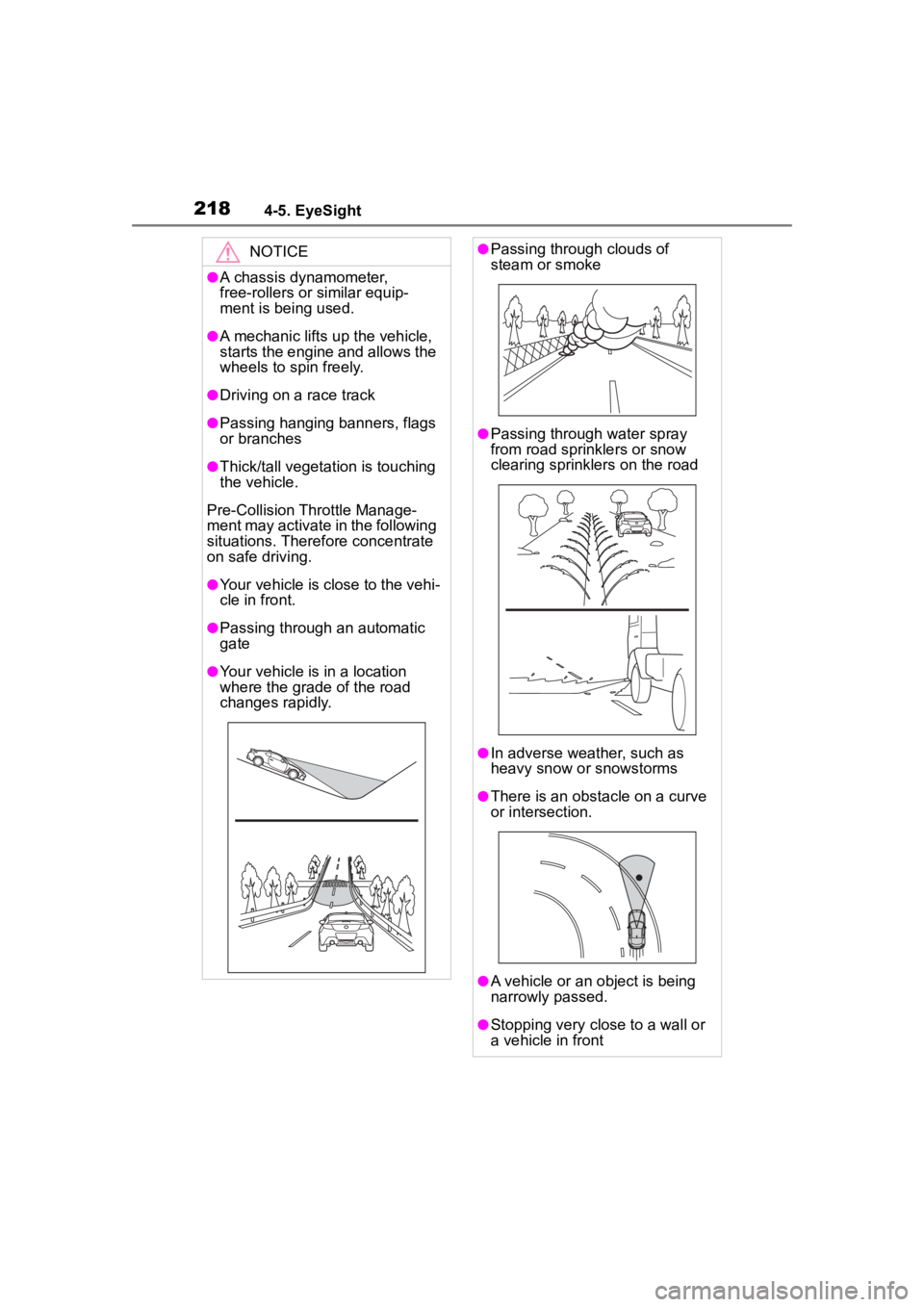
2184-5. EyeSight
NOTICE
●A chassis dynamometer,
free-rollers or similar equip-
ment is being used.
●A mechanic lifts up the vehicle,
starts the engine and allows the
wheels to spin freely.
●Driving on a race track
●Passing hanging banners, flags
or branches
●Thick/tall vegeta tion is touching
the vehicle.
Pre-Collision Throttle Manage-
ment may activate in the following
situations. Theref ore concentrate
on safe driving.
●Your vehicle is close to the vehi-
cle in front.
●Passing through an automatic
gate
●Your vehicle is in a location
where the grade of the road
changes rapidly.
●Passing through clouds of
steam or smoke
●Passing through water spray
from road sprinklers or snow
clearing sprinklers on the road
●In adverse weather, such as
heavy snow or snowstorms
●There is an obstacle on a curve
or intersection.
●A vehicle or an object is being
narrowly passed.
●Stopping very close to a wall or
a vehicle in front